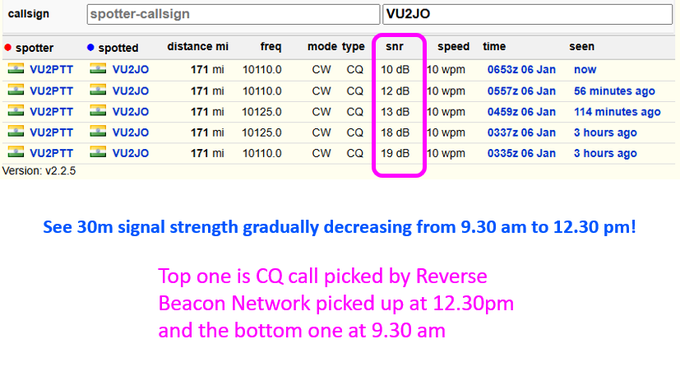Utilizing my 80/20m loaded coil dipole antenna for 30m!
Earlier my loaded coil 80/20m inverted V dipole antenna had tuned to 30m when I had forgotten to tie the lower ends to the supports in the garden. It got back to resonance on 20m after I tied the ends on the lower supports.
As the SWR was not fully up to the mark, I thought of trimming a little more of the elements before the loading coils to get good resonance across the 20m band.
Brought down the antenna and trimmed the elements before the coils. This time I measured elements on both sides and trimming was adjusted to have equal length on either side. I trimmed 10cm on one side and 6cm on the other side for this adjustment. This time I started using my newly purchased industrial gloves while manipulating the ends of the antenna elements to avoid injury to my hands, having learned the hard way several times before!
Remembering my previous mistake, I doubly made sure that the antenna ends were tied to the lower masts in the garden. Still, to my dismay I found that the antenna was resonating only on 10 MHz or 30m band with good SWR across the whole 30m WARC band and not on 20m or 80m. This test was at 10.110 MHz, with SWR at 1:1.
Even near the upper end of 30m band, it was 1:1. You may recall that 30m World Administrative Radio Conference band is a narrow amateur radio band which spreads from 10.100–10.150 MHz only.
Being fed up of multiple trimming, mounting and SWR checks, I decided to accept that result for the time being and try utilizing my new ’30m’ antenna to the best possible extent. A look at the waterfall display on my FT-710 radio told me that currently no signals are visible on 30m band. It has been mentioned that 30m is an excellent DX band which normally has propagation to somewhere in the world at anytime of the day or night and at anytime in the sunspot cycle. The reason why DX contact is possible round the clock is that attenuation due to D layer of the ionosphere is relatively low all year round. This facilitates use of 30m when other bands like 10m, 12m and 17m are no longer usable.
Earlier I had been able to have just one QSO on 30m band with my end fed half wave dipole antenna for 20m, working on 30m with the help of built-in automatic antenna tuner of FT-710. That was with VU2GSM at a distance of 268.4 km, at 6.45 am local time, on 3rd November 2024. Here is the last part of that QSO which I could record then.
Turned to Reverse Beacon Network to check propagation of my signal. You may note that RBN has CW skimmers located at various points of the globe which constantly look for CQ calls on amateur radio bands and is a good tool to check propagation from your setup. Once a CQ call is detected, the skimmer identifies the callsign and automatically posts to the RBN website. You can see that my first CQ call on 10.110 MHz was picked up at VU2PTT at a distance of 171 miles, with a signal to noise ratio of 19 dB. Two other calls were also picked up at VU2PTT on 10.125 MHz, with SNR of 18 and 13 dB respectively. These calls were at around 9.30 and 10.30 am local time. That gave me an idea of local propagation on 30m band. As nobody is likely to be active from this region at that time, I am unlikely to get any QSOs.
Checked once again at 11.30 am and it was picked up at VU2PTT with SNR of 12 dB. So propagation is there on 30m even near noon time, but there are no takers for a CQ call in this region now. I decided to monitor waterfall display for a longer period to pick up any possible activity. For that I switched on the external monitor connected to the radio so that I can view it from a distance when I am doing some other work in my laptop nearby.

They say that 30m propagation is not much affected by D layer attenuation. See the propagation on 30m gradually coming down on 30m from 9.30 am to 12.30 pm local time. Lost propagation by 1 pm. May I request my ham friends around the world to try checking propagation on 30m using reverse beacon network. Planning to check again during the latter part of the day as well.